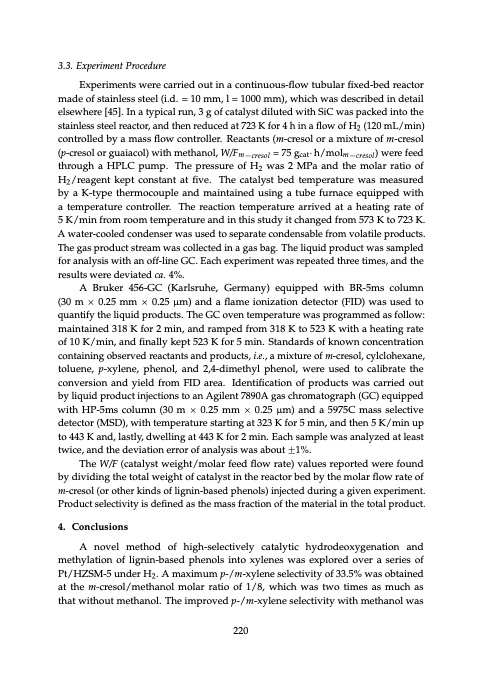
PDF Publication Title:
Text from PDF Page: 235
3.3. Experiment Procedure Experiments were carried out in a continuous-flow tubular fixed-bed reactor made of stainless steel (i.d. = 10 mm, l = 1000 mm), which was described in detail elsewhere [45]. In a typical run, 3 g of catalyst diluted with SiC was packed into the stainless steel reactor, and then reduced at 723 K for 4 h in a flow of H2 (120 mL/min) controlled by a mass flow controller. Reactants (m-cresol or a mixture of m-cresol (p-cresol or guaiacol) with methanol, W/Fm ́cresol = 75 gcat ̈ h/molm ́cresol) were feed through a HPLC pump. The pressure of H2 was 2 MPa and the molar ratio of H2/reagent kept constant at five. The catalyst bed temperature was measured by a K-type thermocouple and maintained using a tube furnace equipped with a temperature controller. The reaction temperature arrived at a heating rate of 5 K/min from room temperature and in this study it changed from 573 K to 723 K. A water-cooled condenser was used to separate condensable from volatile products. The gas product stream was collected in a gas bag. The liquid product was sampled for analysis with an off-line GC. Each experiment was repeated three times, and the results were deviated ca. 4%. A Bruker 456-GC (Karlsruhe, Germany) equipped with BR-5ms column (30 m ˆ 0.25 mm ˆ 0.25 μm) and a flame ionization detector (FID) was used to quantify the liquid products. The GC oven temperature was programmed as follow: maintained 318 K for 2 min, and ramped from 318 K to 523 K with a heating rate of 10 K/min, and finally kept 523 K for 5 min. Standards of known concentration containing observed reactants and products, i.e., a mixture of m-cresol, cylclohexane, toluene, p-xylene, phenol, and 2,4-dimethyl phenol, were used to calibrate the conversion and yield from FID area. Identification of products was carried out by liquid product injections to an Agilent 7890A gas chromatograph (GC) equipped with HP-5ms column (30 m ˆ 0.25 mm ˆ 0.25 μm) and a 5975C mass selective detector (MSD), with temperature starting at 323 K for 5 min, and then 5 K/min up to 443 K and, lastly, dwelling at 443 K for 2 min. Each sample was analyzed at least twice, and the deviation error of analysis was about ̆1%. The W/F (catalyst weight/molar feed flow rate) values reported were found by dividing the total weight of catalyst in the reactor bed by the molar flow rate of m-cresol (or other kinds of lignin-based phenols) injected during a given experiment. Product selectivity is defined as the mass fraction of the material in the total product. 4. Conclusions A novel method of high-selectively catalytic hydrodeoxygenation and methylation of lignin-based phenols into xylenes was explored over a series of Pt/HZSM-5 under H2. A maximum p-/m-xylene selectivity of 33.5% was obtained at the m-cresol/methanol molar ratio of 1/8, which was two times as much as that without methanol. The improved p-/m-xylene selectivity with methanol was 220PDF Image | Zeolite Catalysis

PDF Search Title:
Zeolite CatalysisOriginal File Name Searched:
Zeolite_Catalysis.pdfDIY PDF Search: Google It | Yahoo | Bing
NFT (Non Fungible Token): Buy our tech, design, development or system NFT and become part of our tech NFT network... More Info
IT XR Project Redstone NFT Available for Sale: NFT for high tech turbine design with one part 3D printed counter-rotating energy turbine. Be part of the future with this NFT. Can be bought and sold but only one design NFT exists. Royalties go to the developer (Infinity) to keep enhancing design and applications... More Info
Infinity Turbine IT XR Project Redstone Design: NFT for sale... NFT for high tech turbine design with one part 3D printed counter-rotating energy turbine. Includes all rights to this turbine design, including license for Fluid Handling Block I and II for the turbine assembly and housing. The NFT includes the blueprints (cad/cam), revenue streams, and all future development of the IT XR Project Redstone... More Info
Infinity Turbine ROT Radial Outflow Turbine 24 Design and Worldwide Rights: NFT for sale... NFT for the ROT 24 energy turbine. Be part of the future with this NFT. This design can be bought and sold but only one design NFT exists. You may manufacture the unit, or get the revenues from its sale from Infinity Turbine. Royalties go to the developer (Infinity) to keep enhancing design and applications... More Info
Infinity Supercritical CO2 10 Liter Extractor Design and Worldwide Rights: The Infinity Supercritical 10L CO2 extractor is for botanical oil extraction, which is rich in terpenes and can produce shelf ready full spectrum oil. With over 5 years of development, this industry leader mature extractor machine has been sold since 2015 and is part of many profitable businesses. The process can also be used for electrowinning, e-waste recycling, and lithium battery recycling, gold mining electronic wastes, precious metals. CO2 can also be used in a reverse fuel cell with nafion to make a gas-to-liquids fuel, such as methanol, ethanol and butanol or ethylene. Supercritical CO2 has also been used for treating nafion to make it more effective catalyst. This NFT is for the purchase of worldwide rights which includes the design. More Info
NFT (Non Fungible Token): Buy our tech, design, development or system NFT and become part of our tech NFT network... More Info
Infinity Turbine Products: Special for this month, any plans are $10,000 for complete Cad/Cam blueprints. License is for one build. Try before you buy a production license. May pay by Bitcoin or other Crypto. Products Page... More Info
| CONTACT TEL: 608-238-6001 Email: greg@infinityturbine.com | RSS | AMP |